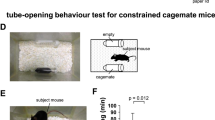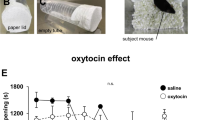Abstract
Helping behavior is a prosocial behavior whereby an individual helps another irrespective of disadvantages to him or herself. In the present study, we examined whether rats would help distressed, conspecific rats that had been soaked with water. In Experiment 1, rats quickly learned to liberate a soaked cagemate from the water area by opening the door to allow the trapped rat into a safe area. Additional tests showed that the presentation of a distressed cagemate was necessary to induce rapid door-opening behavior. In addition, it was shown that rats dislike soaking and that rats that had previously experienced a soaking were quicker to learn how to help a cagemate than those that had never been soaked. In Experiment 2, the results indicated that rats did not open the door to a cagemate that was not distressed. In Experiment 3, we tested behavior when rats were forced to choose between opening the door to help a distressed cagemate and opening a different door to obtain a food reward. Irrespective of how they learned to open the door, in most test trials, rats chose to help the cagemate before obtaining a food reward, suggesting that the relative value of helping others is greater than the value of a food reward. These results suggest that rats can behave prosocially and that helper rats may be motivated by empathy-like feelings toward their distressed cagemate.






Similar content being viewed by others
References
Akyazi I, Eraslan E (2014) Transmission of stress between cagemates: a study in rats. Physiol Behav 123:114–118
Atsak P, Orre M, Bakker P, Cerliani L, Roozendaal B, Gazzola V, Moita M, Keysers C (2011) Experience modulates vicarious freezing in rats: a model for empathy. PLoS One 6:e21855
Barraza JA, Zak PJ (2009) Empathy toward strangers triggers oxytocin release and subsequent generosity. Ann NY Acad Sci 1167:182–189
Bartal IBA, Decety J, Mason P (2011) Empathy and pro-social behavior in rats. Science 334:1427–1430
Bartal IBA, Rodgers DA, Sarria MSB, Decety J, Mason P (2014) Pro-social behavior in rats is modulated by social experience. Elife 3:e01385
Bernhardt BC, Singer T (2012) The neural basis of empathy. Annu Rev Neurosci 35:1–23
Bischof-Khöler D (1991) The development of empathy in infants. In: Lamb ME, Keller H (eds) Infant development: perspectives from German speaking countries. Erlbaum, Hillsdale, pp 245–273
Chen Q, Panksepp JB, Lhavis GP (2009) Empathy is modulated by genetic background in mice. PLoS One 4:e4387
Church RM (1959) Emotional reactions of rats to the pain of others. J Comp Physiol Psychol 52:132–134
Clay Z, de Waal FBM (2013) Bonobos respond to distress in others: consolation across the age spectrum. PLoS One 8:e55206
de Waal FBM (2008) Putting the altruism back into altruism: the evolution of empathy. Annu Rev Psychol 59:279–300
Decety J (2011) The neuroevolution of empathy. Ann NY Acad Sci 1231:35–45
Decety J, Svetlova M (2011) Putting together phylogenetic and ontogenetic perspectives on empathy. Dev Cogn Neurosci 2:1–24
Eisenberg N, Miller PA (1987) The relation of empathy to prosocial and related behaviors. Psychol Bull 101:91–119
Fehr E, Fischbacher U (2003) The nature of human altruism. Nature 425:785–791
Heyes CM, Dawson GR (1990) A demonstration of observational learning in rats using a bidirectional control. Q J Exp Psychol 42B:59–71
Hoffman ML (2000) Empathy and moral development: implications for caring and justice. Cambridge University Press, New York
Killcross S, Balleine B (1996) Role of primary motivation in stimulus preexposure effects. J Exp Psychol Anim Behav Process 22:32–42
Knapska E, Mikosz M, Werka T (2010) Social modulation of learning in rats. Learn Mem 17:35–42
Langford DJ, Crager SE, Shehzad Z, Smith SB, Sotocinal SG, Levenstadt JS, Chanda ML, Levitin DJ, Mogil JS (2006) Social modulation of pain as evidence for empathy in mice. Science 312:1967–1970
Melis AP, Warneken F, Jensen K, Schneider AC, Call J, Tomasello M (2011) Chimpanzees help conspecifics obtain food and non-food items. Proc R Soc Lond B Biol Sci 278:1405–1413
Mogil JS (2012) The surprising empathic abilities of rodents. Trends Cogn Sci 16:143–144
Morris RGM (1981) Spatial localization does not require the presence of local cues. Learn Motiv 12:239–260
Panksepp J, Panksepp J (2013) Toward a cross-species understanding of empathy. Trends Neurosci 36:489–496
Preston SD, de Waal FBM (2002) Empathy: its ultimate and proximate bases. Behav Brain Sci 25:1–72
Rice GE, Gainer P (1962) “Altruism” in the albino rat. J Comp Physiol Psychol 55:123–125
Rutte C, Taborsky M (2007) Generalized reciprocity in rats. PLoS Biol 5:1421–1425
Shamay-Tsoory SG (2011) The neural bases for empathy. Neuroscientist 17:18–24
Silberberg A, Allouch C, Sandfort S, Kearns D, Karpel H, Slotnick B (2014) Desire for social contact, not empathy, may explain “rescue” behavior in rats. Anim Cogn 17:609–618
Viana DS, Gordo I, Sucena É, Moita MAP (2010) Cognitive and motivational requirements for the emergence of cooperation in a rat social game. PLoS One 5(1):e8483. doi:10.1371/journal.pone.0008483
Warneken F, Tomasello M (2006) Altruistic helping in human infants and young chimpanzees. Science 311:1301–1303
Warneken F, Tomasello M (2009) The roots of human altruism. Br J Psychol 100:455–471
Yamamoto S, Humle T, Tanaka M (2012) Chimpanzees’ flexible targeted helping based on an understanding of conspecifics’ goals. Proc Natl Acad Sci USA 109:3588–3592
Zahn-Waxler C, Radke-Yarrow M, Wagner E, Chapman M (1992) Development of concern for others. Dev Psychol 28:126–136
Zentall TR, Levine JM (1972) Observational learning and social facilitation in the rat. Science 178:1220–1221
Acknowledgments
This work was supported by JSPS KAKENHI Grant Number 26118514 and 24500481.
Conflict of interest
The authors declare no conflict of interest associated with this study.
Author information
Authors and Affiliations
Corresponding author
Electronic supplementary material
Below is the link to the electronic supplementary material.
Rights and permissions
About this article
Cite this article
Sato, N., Tan, L., Tate, K. et al. Rats demonstrate helping behavior toward a soaked conspecific. Anim Cogn 18, 1039–1047 (2015). https://doi.org/10.1007/s10071-015-0872-2
Received:
Revised:
Accepted:
Published:
Issue Date:
DOI: https://doi.org/10.1007/s10071-015-0872-2




